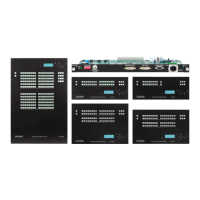4. Operation MX-FR Series Modular Matrix Frames – User's Manual 44
The Audio mode settings are available in the case of MX-TPS-OB-A and
MX-TPS-OB-S boards. Here can be selected which is embedded in the
forwarded HDMI signal can be set to No audio (A), HDMI audio passth.
(B), Embed from Ext (C), Deembed to Ext (D) or HDMI + deemb (E).
The DVI or HDMI 5V line can be
controlled on an output port with the
PWR5V mode. If it is On the 5VDC is
always active. If it is Off the port never
sends the 5 VDC.
ATTENTION! If the 5V line is off sink devices do not send HotPlug
signal in most cases and their EDIDs will not be read.
The Auto mode means the port gives the 5V but if the video signal
changes (e.g. resolution) it turns off the 5V for 1 sec and turns it on
again.
TIPS AND TRICKS: This mode is useful for sink devices which are
not able to handle properly the changing of the video signal.
The Analog Audio Output settings are
available in the case of boards with
analog audio add-on ("-A" extension).
The submenu contains the attributes
of the analog audio signal.
input (embed) the options are
the followings: volume, balance gain, phase (inversion), DC Filter.
In the case of output (deembed) the
options are: volume, balance, bass,
treble, deemphasis, phase (inversion), DC
Filter.
The TPS mode can be HDBaseT,
Longreach, Automatic, RS232 only and
RS232+ETH only.
For detailed information about the
TPS modes see the TPS Link Modes
section.
The PoE setting (remote Power over
Ethernet) is available only in the case
of TPS2 boards. Set the desired mode
(enable/disable).
Output 7 settings
HDMI + deembed
~PWR5V mode ~
~<Auto >~
Output 7 settings
Audio mode
HDMI + deembed
~Analog Audio Inpu>>
Analog Audio Input~
~Volume ~
~< 0 dB >~
Balance
Output 7 settings
Analog Audio Input.
~TPS mode ~
~<HDBaseT >~
Input 17 settings
Automatic
~PoE ~
~<Disable >~
Supported Boards: MX-HDMI-3D-OB, MX-HDMI-3D-OB-S,
MX-HDMI-3D-OB-A, MX-4TPS2-4HDMI-OB, -A, -S, -P, -AP, -SP,
MX-DVI-4K-OB
Use the up ▲ and down ▼ buttons to select the parameter to be
changed. Use the left ◄ and right ► buttons to change the value.
The Signal mode can be set to DVI, HDMI
or Auto mode. The Auto option sets the
signal mode according to the attached
incoming signal. Use the left ◄ and
right ► buttons to change the value.
The Encryption option sets the HDCP
encryption on the output. The Auto
setting applies encryption when the
incoming signal is encrypted. The
Always setting forces encryption on
any incoming video signal. Use the left
◄ and right ► buttons to change the value. For detailed information
about the HDCP modes see the HDCP Management section.
The Test pattern generator makes it
simple to test and troubleshoot video
hook-ups and displays. Use the left ◄
and right ► buttons to change the
value. On turns on, Off turns off the
test pattern generator. If it is off, the
output gives a solid black, 480p video signal. (This is the default
value.) In the case of No signal mode, the output does not give any
signal.
Three options can be selected for
the resolutions of the TPG: 480p 60Hz,
576p 60Hz and Odd p. signal. Odd p.
signal means the resolution of the
test pattern is the same as the closest
(Input 1 for the input 1 and 2, Input 3
for input 3 and 4, and so on…) If there
is no video signal on the odd input, the
generator gives a 480p signal.
The pattern can be solid green, blue, black, white or black and white ramp
and chessboard or color bar. The cycle changes all the listed ones
periodically.
Output 3 settings
~Signal mode ~
~<HDMI >~
Encryption
Output 3 settings
~Encryption ~
~<Always >~
TPG mode
Output 3 settings
Auto
~TPG mode ~
~<on >~
Output 3 settings
On
~TPG clk ~
~<Odd p. Signal >~
Output 3 settings
Odd p. Signal
~TPG pattern ~
~<Color bar >~
The Audio mode settings are available in the case of MX-HDMI-3D-OB-A
and MX-HDMI-3D-OB-S boards. Here
can be selected which is embedded in
the forwarded HDMI signal can be set
to No audio (A), HDMI audio passth. (B),
Embed from Ext (C), Deembed to Ext (D)
or HDMI + deemb (E).
The DVI or HDMI 5V line can be
controlled on an output port with the
PWR5V mode. If it is On the 5V DC is
always active. If it is Off the port never
sends the 5 V DC.
ATTENTION! If the 5V line is off sink devices do not send HotPlug
signal in most cases and their EDIDs will not be read.
The Auto mode means the port gives the 5V but if the video signal
changes (e.g. resolution) it turns off the 5V for 1 sec and turns it on
again.
INFO: This mode is useful for sink devices which are not able to
handle properly the changing of the video signal.
The Analog Audio Output settings are
available in the case of MX-TPS-OB-A
board. The submenu contains the
attributes of the analog audio signal.
input (embed) the options are: volume,
balance, gain, phase (inversion), DC Filter.
In the case of output (deembed) the
options are: volume, balance, bass,
treble, deemphasis, phase (inversion), DC
Filter.
Output 3 settings
Audio mode
HDMI + deembed
~Analog Audio Inpu>>
Output 3 settings
HDMI + deembed
~PWR5V mode ~
~<Auto >~
Volume
0 dB
~Balance ~
~< 50 % >~
Analog Audio Input~
~Volume ~
~< 0 dB >~
Balance
Output 3 settings
Audio mode
HDMI + deembed
~Analog Audio Inpu>>

